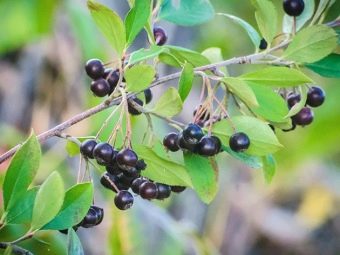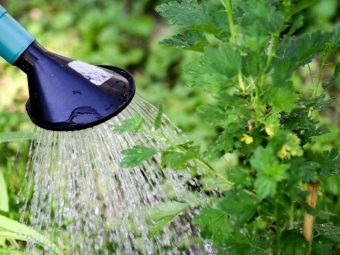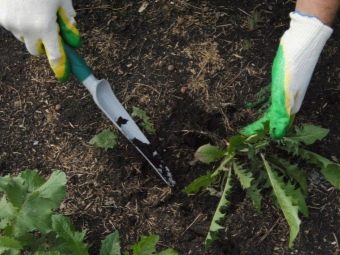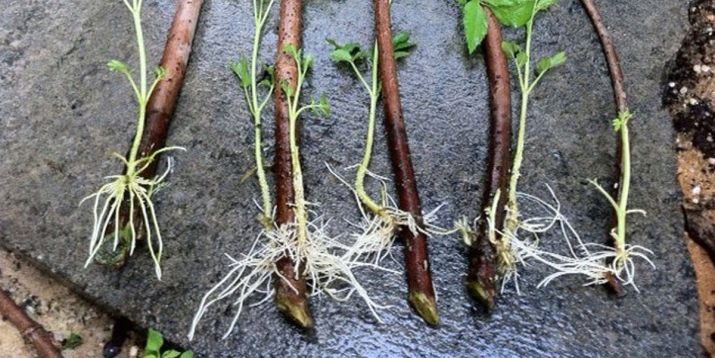Useful tips on the cultivation of chokeberry and care for her
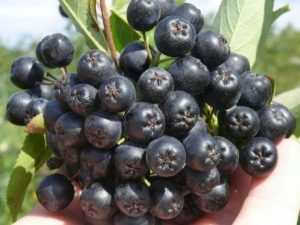
Chokeberry (aronia) is a fruit tree or shrub. It does not grow in the wild in Russia, but is only cultivated. The fruits of the shrub have many useful properties, as well as widely used in the food industry. Useful tips on the cultivation of chokeberry and care for it are presented in detail below.
Special features
Homeland chokeberry is North America, where the bush grows wild. The length of the highly branchy plant can reach 3 meters. Chokeberry is a perennial and cold-resistant shrub. The shrub can grow on almost any soil and is easily transplanted to a new site.
Aronia blooms at the end of spring or early summer. In early autumn, the shrub looks no less beautiful than during the flowering period. In September, the leaves of the plant change shade and become purple-red.
Aronia can be planted on the plot as a hedge to decorate the cottage. It must be remembered that such a shrub is a light-loving plant. Aronia was originally grown as an ornamental shrub until such time as the beneficial properties of its fruits were discovered.
The berries of the plant contain many beneficial microelements and vitamins, due to which they are actively used in traditional medicine. Chokeberry fruits are larger than ordinary rowan berries and have a sweet and sour astringent taste. The first fruits appear in the fourth year of the bush life. Full ripening depends on climatic conditions and varieties of mountain ash, but most often the berries are harvested in the second half of September.
Fresh chokeberry berries can be used as an additional source of vitamins, as well as with essential hypertension. Fruit juice is used to strengthen capillaries and arteries.
Not only aronia berries, but also leaves have useful properties. Tea from the leaves of Aronia rowan improves the outflow of bile and liver, and also has a diuretic effect.
Sorta
Thanks to the efforts of breeders, there is a huge number of varieties of chokeberry chokeberry. Each variety has its own distinctive features, be it the rules of cultivation and care, or the taste and color of fruits. Consider the most popular chokeberry types:
- Viking;
- Nero;
- Rubin;
- Hugi;
- Blackaway;
- "Aronia Michurin".
"Viking"
Variety bred by Finnish breeders. Shrub resistant to frost and has a high yield. The size of the berries is small, and their number in the shield can be 20 pieces. The shiny and slightly flattened fruit are black with a purple tinge.
"Nero"
Differs in high resistance to frosts. In addition, this variety is less light-requiring and can be grown in the shade. The size of the shrub is not very large. In length, the plant can reach two meters.
The fruits of Aronia rowan "Nero" are quite large compared to the fruits of other varieties. The berries have improved taste and flavor, as well as increased the content of nutrients in the fruit.
"Rubin"
It is one of the hardiest varieties. Such chokeberry perfectly tolerates severe frosts, and also has a high resistance to various diseases and insect pests. Fruits have a diameter of not more than 1 cm and ripen in early autumn.
"Hugi"
Bred by Swedish breeders. The variety belongs to the category of highly ornamental shrubs. Aronia can be no more than 2 meters long. In the summer, the leaves of the shrub are green and very bright, and in the fall their hue becomes saturated red.
The berries of the Hugi plant ripen completely a little later than the fruits of other varieties of chokeberry Aronia, as well as less juicy.
Aronia of this type needs special care. When pruning the bushes plants need to be especially careful.
Blackaway
This rowan is unpretentious in growing and care. The variety has a high resistance to diseases and garden pests.The fruits of the plant are of little tartness when compared with the taste properties of other types of chokeberry berries.
"Aronia Michurin"
It is one of the cold-resistant species of shrubs of the pink family. In January-February, the shrub easily tolerates frosts to –40 degrees. In height, this variety can reach more than three meters. The fruits of the shrub are not quite rounded, oblate shape. The berries are quite large, juicy and do not crumble from the bushes.
Planting and care
Planting mountain ash is recommended in the autumn. Most varieties of chokeberry are light-requiring, therefore it is recommended to choose well-lit areas for planting. In the shade black chokeberry will also grow and bear fruit, but its berries will be less juicy and healthy.
Soil preparation
Despite the fact that chokeberry can grow on almost any soil, it is recommended to prepare the soil before planting. Due to the fact that the shrub has a small root system, it can be planted in wetlands or in places where the groundwater is quite high.
Ideal soil will be neutral or with low acidity soil. It is recommended to prepare the place at least one week before landing. The selected area can be pre-sown with alfalfa, which will contribute to a better distribution of fertilizers.
Before planting Aronia, it is recommended to fertilize the land with manure.
Disembarking
When planting several black chokeberry bushes, the distance between them should be at least two meters. If aronia is planted with one shrub, then it must be located at a distance of at least three meters from other large plantations in the garden. The optimal dimensions of the pit under the seedling are 60 cm wide and 40 cm deep.
In the prepared pit, you must put a little humus or mineral fertilizers. You can prepare a mixture of the fertile part of the soil, a small bucket of humus, 120 g of superphosphate and potassium chloride. The resulting composition must fill a third of the volume of the dug pit and fill with a bucket of water.
After the water is absorbed into the ground, you can start planting a seedling. The roots of chokeberry can be processed with a clay mash creamy consistency. The prepared seedling is placed in a hole, gently straightening the root system and covered with soil.
After planting the shrub must be poured abundantly with water.
How to follow the shrubs?
Chokeberry is unpretentious and easily takes root after planting in almost any soil. However, for good and abundant fruiting, as well as for the purpose of extending the life of the shrub, the plant should be regularly maintained. First of all, aronia needs a large amount of moisture, especially if it grows in a hot arid climate. The shrub needs regular watering.
In the spring, it is necessary to cut off unnecessary shoots, which will contribute to abundant fruiting. Fertilizing shrub is recommended at least three times during the season. However, in the first two years after planting, the plant does not need additional feeding.
The first top dressing should be carried out in the spring, when leaves just start to appear on the bush. The second time Aronia fertilized during the flowering period. The last dressing for the season is held in the autumn, after picking the fruit.
Seven years after planting chokeberry, it is necessary to rejuvenate the shrub and carry out the planned pruning of the branches. Dry old branches must be completely cut, leaving no more than 25 young branches. Every year in April, the shrub is recommended to be treated with special compounds against pests of garden plants. In May, it is necessary to remove the weeds.
Breeding
There are several methods that can be used for breeding black chokeberry bushes. Aronia propagates as follows:
- seed multiplication;
- grafting;
- division of the bush;
- reproduction of ground shoots (layering);
- offspring of the root system;
- by vaccination.
Consider the most popular methods in more detail.
Seeds
For breeding chokeberry quite often use seeds that are extracted from ripe berries. Planting seeds can be carried out immediately after harvest. Also, the seeds can be stored in a fabric bag or placed in a container with moistened sand and sent to storage in the basement before spring.
In the spring, it is necessary to plant the seeds in small furrows, a depth of no more than 8 cm. Furrows are covered with soil no more than 5 millimeters, and then covered with sawdust or humus. When the first shoots form on the surface, they must be thinned in steps of three centimeters.
The seedlings are processed a second time when at least five young leaves appear on them, in 6 cm increments. The last treatment should be carried out in a year in the spring, and the distance between the shoots should be 10 cm. In about two years, in early autumn transplant chokeberry to a permanent place.
Cuttings
In order to propagate the chokeberry by the method of cutting, woody or green cuttings will be required. In the first case, it will take mature shoots that are not more than one year old from the branches of a three-year-old shrub. Cuttings are harvested in early autumn with a length of 15 to 20 centimeters and with 5 buds.
On the handle you need to make two oblique cuts: the upper cut in the direction of the eye, and the bottom - under the eye. Planting of planting material is made on the day of its procurement. The cuttings are planted with a step size of 10 centimeters, while maintaining an angle of 45 degrees.
The use of green cuttings for the reproduction of the shrub allows you to get ready seedlings in a shorter time. However, this method can be applied only in the case of a cold greenhouse. On the soil in the greenhouse poured river sand. The thickness of the buried sand layer should be 100 millimeters.
Harves cuttings no longer than 15 cm. From the bottom of it is necessary to remove all the leaves. You need to leave only the top three sheets, which are shortened by two thirds. Small longitudinal incisions should be made above the kidneys.
For the best development of the root system, the cuttings are sent to a special solution that stimulates growth and last for about ten hours. Next, planting material is washed with water and transplanted into the prepared soil in 4 cm increments. After planting, the cuttings should be watered well.
Root offspring
Aronia Aronia refers to self-pollinating plants, so it is most convenient to multiply it with the help of offspring roots. During the summer period, near the shrub appears root shoots. Using a shovel or other sharp object, a part of the root system is allowed to be cut off and landed at a new site.
Graft
Vegetative propagation by the grafting method involves the connection of parts of different plants. To propagate black chokeberry, it is best to take a stock in the form of a sapling of the usual mountain ash. The seedling must be cleaned of dirt and cut at a level of 12 cm. The stock is cut deep along its entire length.
Aroniya stalk must be trimmed on both sides in order to get a wedge that will need to be placed in the incision on a mountain ash. When the chokeberry chokeberry is fixed in the cut of the seedling, the cuttings of the cutting and the seedling are covered with garden pitch, and the cut is wrapped in a special graft film.
The seedling must be wrapped with plastic wrap and secure the material on the site, which is located below the scion. After four weeks, polyethylene can be removed.
Recommendations
Planting shrubs and chokeberry rowan are not particularly difficult. However, it is imperative to buy quality planting material.It is recommended to buy chokeberry from reliable suppliers and in special nurseries. If rowan is needed to be planted in order to decorate the landscape, then it is best to move the aronium on the trunk.
Make a purchase is recommended in the autumn. The range and quality of planting material at this time of year is much higher. The root system of the plant should not be damaged. After purchasing the seedlings, it is recommended to moisten the roots in water and close with a plastic bag before planting.
Young shrubs can not tolerate frosts, so they are recommended to prepare for the first winter. Neighboring branches are tied to each other and tied to wooden stakes, which must first be driven into the ground next to the bushes. The tied branches will perform a protective function, since snow will accumulate on them, preventing the roots from freezing.
To learn how to plant and care for chokeberry, see the following video.












